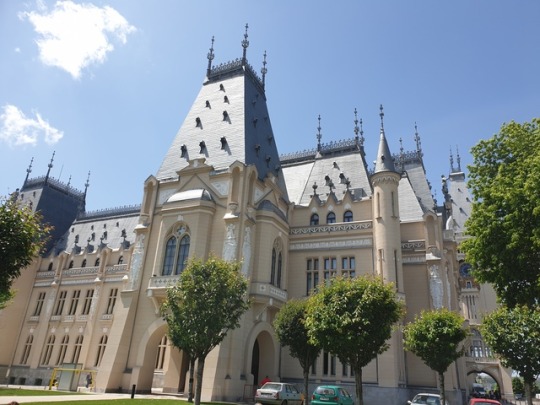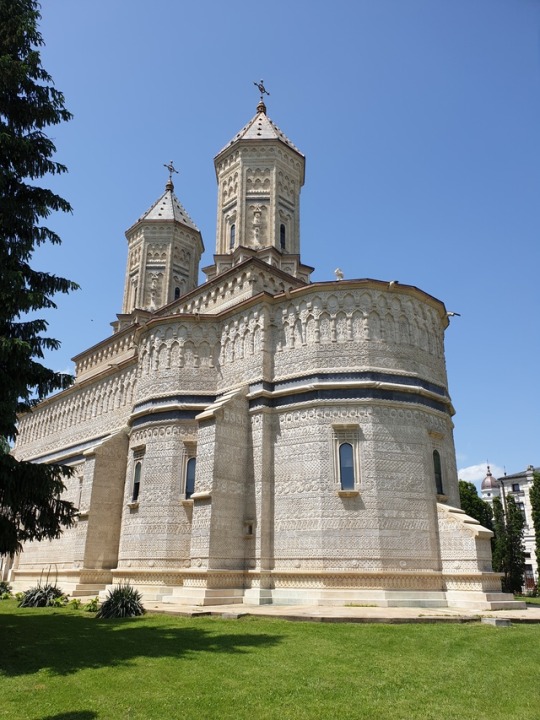#st paraschiva
Text

Sfânta Vineri, our fairy tale grandma.
Be kind to old women kneeling by the church door because that's how Vineri(Friday) spends most of her time and you don't want to show a goddess you're an ass. When she's not praying for the forgivness of mankind Vineri is lending a helping hand to a Făt-Frumos or Cosânzeană, being the most frequent magical helper in fairy tales. There is a version of her being a mean old widow who wonders the world punishes women who work on her day by destroying their work and making a mess in their house untill you trick her to leave and you need to put all vessels upside down to prevent her from comming back. That is most likely the older version because it mentions her having temples and some still use her old name Venera-which, yes, comes from Venus cause Rome wasn't Rome without her genetrix. But that lost popularity to the saintly version which is heavealy associated with saint Paraschiva, especially in Moldova, basil being a flower sacred to both of them.
#vineri#romanisme#romanian mythology#romanian folklore#st paraschiva#myth#mythology#folklore#fairy tales#fat frumos#Ileana cosanzeana#illustration#ink#drawing#art#pen and ink#artists on tumblr
37 notes
·
View notes
Text
The village was first recorded in 1770. The wooden church is named after its patron saint, ”St. Paraschiva”(a saint from Moldavia), and was built in 1932 in the upper part of the village, on a hill, by the orthodox community. The craftsmen used beech beams, covered on the exterior by horizontal laths, except for the space around the windows, which are covered by vertical laths, creating the impression of access doors.
The structure has a small porch, covered by the extended front part of the bell-tower. The disconnected apse is pentagonal. The interior was divided into small equal surfaces, which were covered by vertical laths, with no paintings.
The roof is made of dovetailed shingles. The bell-tower has a hidden watch-tower with two small side openings in the upper part, and a larger one in the lower part. Above it there is a large conical spire, ending with a simple cross.
The painting on the walls was replaced by icons on plywood created by painter Pop Aurel from Baia Mare.
The Iconostasis is really, remarkable. It was brought from the old wooden-church from
Fauresti, which was demolished when a new church, made of stone, was built. The iconography of the Iconostasis is impressive and original because of the framing of surfaces from one tier to another. In the first row, one can see God Almighty at the symbolic axis, in the middle. Scenes from Christ’s Life are on each side in square frames, (except the ones on the sides, which are in rectangular frames), and include “The Last Supper”, and the Apostles, all between the arches of the church and make up the second row. The colonades of the church are decorated with bunches of grapes and cross-shaped flower petals. The third row presents Jesus as Priest between the Prophets, on two rows; in square medallions in the lower row, and circular medallions (surrounded by rays of light), in the upper row.
The Iconostasis has not the usual upper tier picturing Jesus on the Cross and, but this does not affect the overwhelming impression of the assembly.
Bloaja II wooden church, general view
BLOAJA (IZVOARE II) wooden church, NEAR CERNESTI, Maramures, Romania The village was first recorded in 1770. The wooden church is named after its patron saint, ”St.
1 note
·
View note
Text
Iasi, Romania...
28 May
We said goodbye to Chisnau and head across the border to Iasi,(pronounced yahsh ), one of the oldest cities in Romania. What a cool and vibrant little university town. It's also seen as a cultural and economic hub for both Moldova and Romania, previously being a major trade route between Poland , Russia, Hungary and Constantinople. Our local guide gave us a fantastic tour of the city sights. The first stop on our tour was the Palace of Culture, a huge neo-Gothic building constructed (1906-1925), stands partly on the ruins of a medieval royal court mentioned in documents dating from 1434. Today, the 365-room palace houses the Gheorghe Asachi Library and four of the city's museums. It’s a stunning building overlooking the square, and Palas park, draws all attention from any angle, particularly gorgeous at night when its lit up!



In the center of the city is the huge 19th Century Italian renaissance style St. Paraschiva Metropolitan Orthodox Church. Nearby is the Three Hierarchs Monastery with an exterior entirely decorated with delicate, Moorish-style stone carvings, an amazing building to just stand and take it all in - the intricate detail is insane. The area around the city centre is scattered with gorgeous buildings and a variety of Cathedrals, referred to as the ‘golden plateau’ of the city (as there apparently over 100 in the area). Our guide took us underneath the Metropolitan Cathedral to the huge metropolitan museum space within winding tunnels and open rooms under the church. Unfortunately I wasn't feeling that crash hot by that stage (my body was trying to defeat me in its monthly attack) so I missed some of the stories when we were underground. It did, however hold some amazing examples of Romanian decorated eggs. It’s a huge part of their culture to paint intricate designs on empty egg shells for Easter each year. A tradition that has neen in place over at least the last two centuries. There is alot of meaning behind the colours and designs used by each artist and like the rugs in Morocco they tell a story of what's happened in the artists life. No photos were allowed, although I may have sneaked a shot of the baptismal fountain area which had an amazing roof that allowed you to see light from the square above.




Our guide advised us that Iasi has never had a major shopping centre, nor were the people used to supermarkets. Now they have both. The huge shopping centre constructed on the town square forms a major hub of the city, and was very busy. The Auchen supermarket was one of the biggest I've seen on my journeys. It was fun wandering through with one of my bus mates - unicorn tissues for the win!



0 notes
Text
مدينة ياش الرومانية بالصور
مدينة ياش: هى واحدة من أعرق المدن الرومانية، وهى تكتب Iaşi ،وتنطق ياش، وتعد ياش رابع أكبر مدينة من حيث عدد السكان في رومانيا بعد ثلاثة مدن من بينهم بوخاريست، كما أنها واحدة من أهم المدن الثقافية والتاريخية في رومانيا، حيث تحتوي على ثاني أكبر جامعة في الدولة، وتقع ياش في شمال شرق رومانيا بالقرب من الحدود مع دولة مولدافيا، ويطلق عليها مدينة التلال السبعة الأسطورية.
لمحة تاريخية عن مدينة ياش:
تسمى مدينة ياش مدينة “قصص الحب الأسطورية”، “ومدينة البدايات الجديدة”، و”المركز الثقافي لمولدافيا”، وقد عرفت ياش منذ أوائل القرن التاسع عشر بروحها الوطنية التي تنتمي للدولة الرومانية، فكل ركن وحجر وزاوية في مدينة ياش يحمل جانباً من عبق الماضي والروح الرومانية التاريخية.
وقد ظهر إسم مدينة ياش في الوثائق التاريخية لأول مرة في عام 1408 في فترة حكم الاسكندر سيلبن، حيث كانت المدينة عبارة عن منفذ تجاري وإستثماري تم إنشائه بواسطة الإسكندر لتسهيل عمليات التجارة في ذلك الوقت، وقد إستمرت المدينة في التطور عبر العصور حتى أصبحت واحدة من أقدم المدن التاريخية الرومانية.
أهم المعالم السياحية في مدينة ياش الرومانية
1- قصر الثقافة Palatul Culturii
تم تأسيس هذا القصر في الفترة من 1906 وحتى 1915، وهو واحد من ألمع المباني التاريخية والثقافية في المدينة، حيث تم إقامته على أنقاض محكمة مديفيال الملكية، التي تم ذكرها في العديد من الوثائق التي تعود لعام 1434، ويحتوي القصر على 365 غرفة من بينها مكتبة جورج آشاسي الشهيرة، وأربعة من أهم المتاحف وهى متحف مولدافيا التاريخي، والمتحف الإثنوغرافي، ومتحف الفنون، ومتحف العلوم والتكنولوجيا، وأهم ما يميز هذا القصر بالإضافة إلى قيمته التاريخية هو روعة البناء وتصميمه الداخلي الفخم المحفوف بالأثاث الراقي الذي يعود لعقود مضت.
2-كاتدرائية متروبوليتان St. Paraschiva” Metropolitan Cathedral
بنيت هذه الكاتدرائية على النظام الإيطالي وتعد كاتدرائية سانت بارشيفيا واحدة من أكبر الكنائس الأرثوزوكسية في رومانيا، وقد بدأ بناؤها في عام 1833 وانتهى في عام 1839، وينظر لهذه الكنيسة على أنها مكان مقدس للمسيحيين في هذه المنطقة، حيث يقومون بالتوجه إليها في الرابع عشر من أكتوبر من كل عام لزيارتها وإقامة شعائرهم الدينية هناك.
3-قصر روزنافو . قاعة المدينة Roznoveanu Palace / City Hall
تم بناء هذا القصر في عام 1832 على طراز مدينة فينسيا على يد جوستاف فري والد، ويتميز القصر بتزينه بالرخام الخالص، وقد احترق هذا القصر في عام 1844 وأعيد بناؤه مرة أخرى في عام 1891، وهو حالياً يمثل القاعة الأساسية التي تقام فيها الإحتفاليات في هذه المدينة.
4-المسرح القومي “مسرح فاسيل الكسندر” National Theatre
تم بناء هذا المسرح في أواخر القرن التاسع عشر، وهو واحد من أفخم وأعرق الأبنية في رومانيا، وقد تم بنائه على يد مهندسيين من مدينة فينيس، بينما تم إنهاء أعمال الديكور والتشطيبات على النمط الفرنسي الحديث، ويتسع المسرح لألف شخص، ويحمل المسرح اسم مؤسس المدينة فاسيل الكسندر.
5-جامعة ياش Iasi University – Copou Hill
تم بناء المبنى الرئيسي للجامعة في الفترة من عام 1893 وحتى عام 1897، وذلك في موقع المسرح الكبير الذي إحترق سابقاً، وتعد قاعة آثار الأقدام المفقودة هى أشهر قاعات هذه الجامعة، حيث تم إستخدامها كقاعة للبرلمان وذلك في عام 1917، وعام 1918، وتعد هذه الجامعة من أقدم الجامعات الرومانية.
6-كنيسة بانو
بنيت كنيسة بانو عام 1705، وقد أعيد بناؤها مرة أخرى عام 1799، وهى نموذج حي للكلاسيكية الخاصة بهذه المدينة، ويتمثل ذلك في الطراز الذي بنيت عليه هذه الكنيسة.
7-متحف مولدافيا الاثنوغرافي
يعد هذا المتحف من أفدم وأكبر متاحف المدينة، حيث يحتوي على 16 حجرة تحكي التاريخ ونمط الحياة لمدينة مولدافيا قديماً.
من منتديات بيت حواء - حول العالم http://ift.tt/2FNnGkY
0 notes